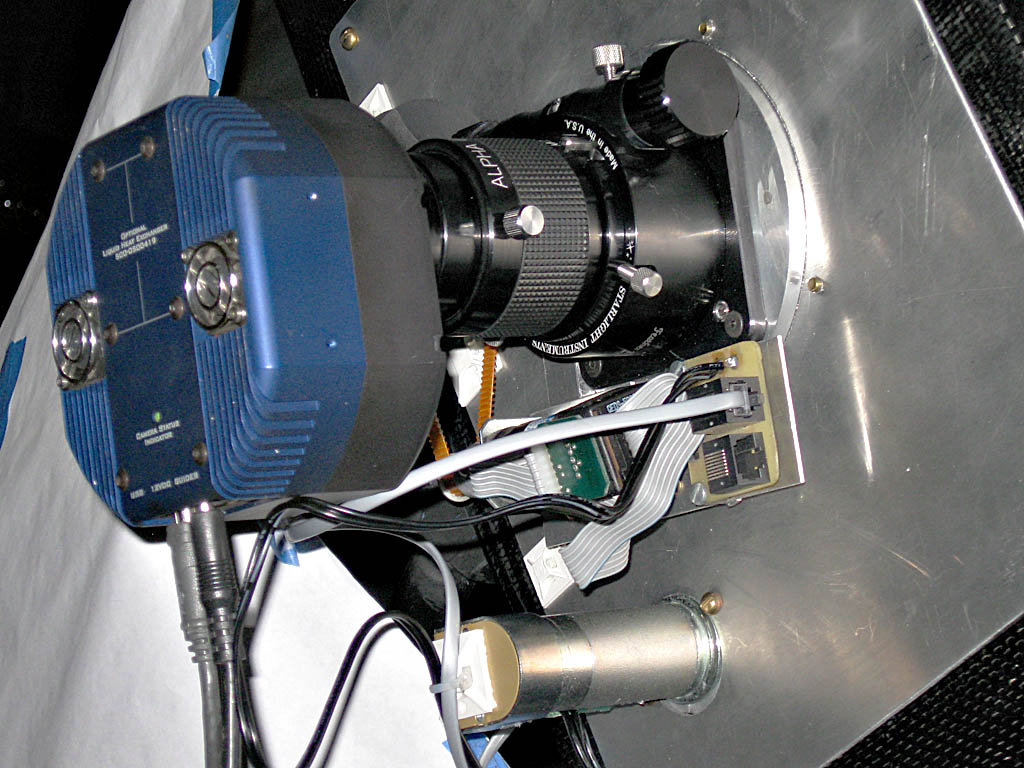
Cal Poly 18 Bulletin 07
2012-01-12: Everything works!
Everything came together for the Cal Poly 18 on the night of January 11, with Dan and Richard at TMS. First, it was all blue-sky day all day, and it remained spectacularly as darkness fell. Second, we completed a lengthy to-do list just in time to set the telescope in the parking area behind TMS. Third, we have a pretty good idea why our last several pointing models were poor (see Bulletin 06), and were therefore able to make a pointing model with an r.m.s. error of 14 arcseconds with just a few terms, and 7 arcseconds with lots of terms. Fourth, after some head-scratching, the focuser focused and the rotator rotated, and after more head-scratching, the rotator rotated in the correct direction at the correct rate. Fifth, the automatic focusing routine in PointXP made focusing quick and easy instead of slow and painful. Then we tested Dan's new satellite find and track feature in SciTech, and we found and followed the first satellite (an Atlas-Centaur, Norad = 05816) we tried to find, and made a 60-frame movie of the satellite sitting stationary in the field while stars shot past. We tested tracking accuracy, obtaining round star images with 300-second exposures of M33. Lastly and leastly, we made an LRGB "pretty picture" of the Orion nebula.
The To-Do List
Mirror Cell
While Dan was checking the driver boards, I (Richard) collimated the mirror and observed that the return laser spot moved downward ~3 mm between 60 degrees elevation and 5 degrees elevation (i.e., a shift in the optical axis of the mirror by ~2 arcminutes). Probing the cell with finger pressure, I found that from a horizontal start, the miror did not appear to seat firmly against the 18-point wiffletree supports until the telescope reached an elevation of 10 degrees. Using a dial indicator, at an elevation of -5 degrees, the distance from the cell support to the bottom edge of the mirror was +0.002, at +10 degrees, 0.000, at +30 degrees, -0.001 , and at 75 degrees, -0.001 inches (i.e., as the telescope was raised, the mirror settled against the cell). The elevation angles were estimated, and the dial indicator could be estimated to 0.0001. The mirror therefore rotated by ~1 arcminute, approximately. While the measures are rough and not in perfect agreement, they indicate unwanted movement of mirror relative to the optical tube assembly.
Longitudinally, the mirror should rest against the 18-point wiffletree flotation cell. Radially, the miror is constrained by four bolts equally spaced around the circumference. The mirror rests on the two lower bolts, spaced 90 degrees apart. Each bolt is sheathed in a blue plastic sleeve, probably a shrink-wrap material. The blue plastic is soft and can be dented with fingernail pressure; between the edge of the mirror and the blue plastic you feel considerable friction (i.e., heavy finger pressure is needed to slide the mirror forward along the support when the elevation of the tube is ~30 degrees).
What appears to happen is that if the tube is brought horizontal or lower, the mirror moves forward on the bolts. As the tube elevation increases, the mirror does not not slide freely, so it does not initially contact the longitudinal supports. By an elevation of 30 degrees, however, the mirror does appear to rest at least partially against the 18-point support. If the telescope is pointed near the zenith, the mirror seats firmly on the 18-points, but it may remain on them until the tube is nearly horizontal. While building a pointing model, the telescope moves from elevations as low as 20 degrees to nearly 90 degrees. Depending on the order in which pointings occur, the observed field can be displaced by different amounts in elevation due to the suspected mechanical hysteresis in the cell. This results in a model with r.m.s. errors on the order of an arcminute, and possibly different quality of fit for the east and west sky.
On 2012-01-11, we built a 16-point model using stars with elevations of 30 degrees or greater. The r.m.s. fit for a simple model was 14 arcseconds. We suspect that the higher elevations ensured that the mirror was seated against the 18-point longitudinal supports. Although more must be done, we think we have identified a mechanical problem and a suitable method for building accurate pointing models. For the long term, we need to verify these observations and possibly correct the radial supports for the mirror to allow free longitudinal motion.
Focus Change
Autofocus allowed us to determine a best focus within about 0.001 inches. Although we did not record the times, here are the best focus values obtained at irregular intervals between 7:30 pm and 10:30 pm: 0.4971, 0.4984, 0.4963, 0.4872, 0.4777, 0.4841, and 0.4698. The difference between extreme value is ~0.030. We put the telescope around 5:30 pm and made the first focus determination around 7:30 pm. The outside temperature was ~26 F, and did not fall by a large amount during the three hours we measured the focus position. It is not clear at this time whether the focus change is a fucntion of time or temperature.

This is the focuser/rotator. On 2012-01-11, we inserted a 1.5-inch focus extension (labelled "ALPHA").
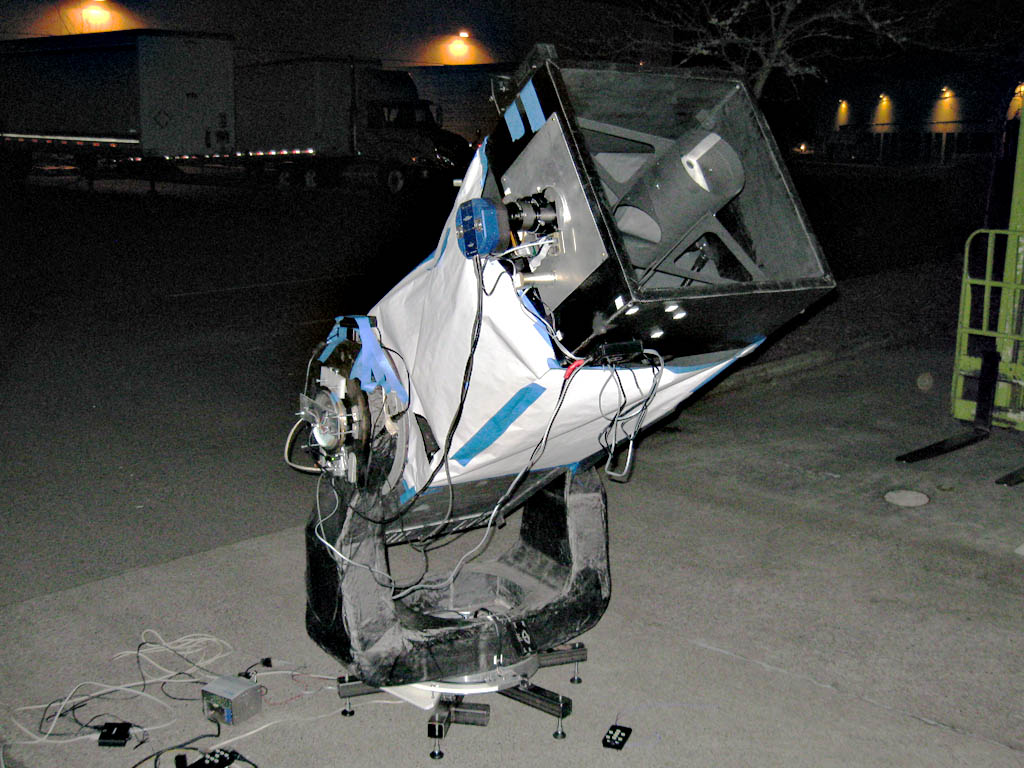
The Cal Poly 18 as it appeared during testing. The temporary paper covering is black on the inside to reduce scattered light from lights on the surrounding industrial buildings. It had gotten quite crinkled, but still manages to keep much of the light from the surroundings from reaching the CCD.
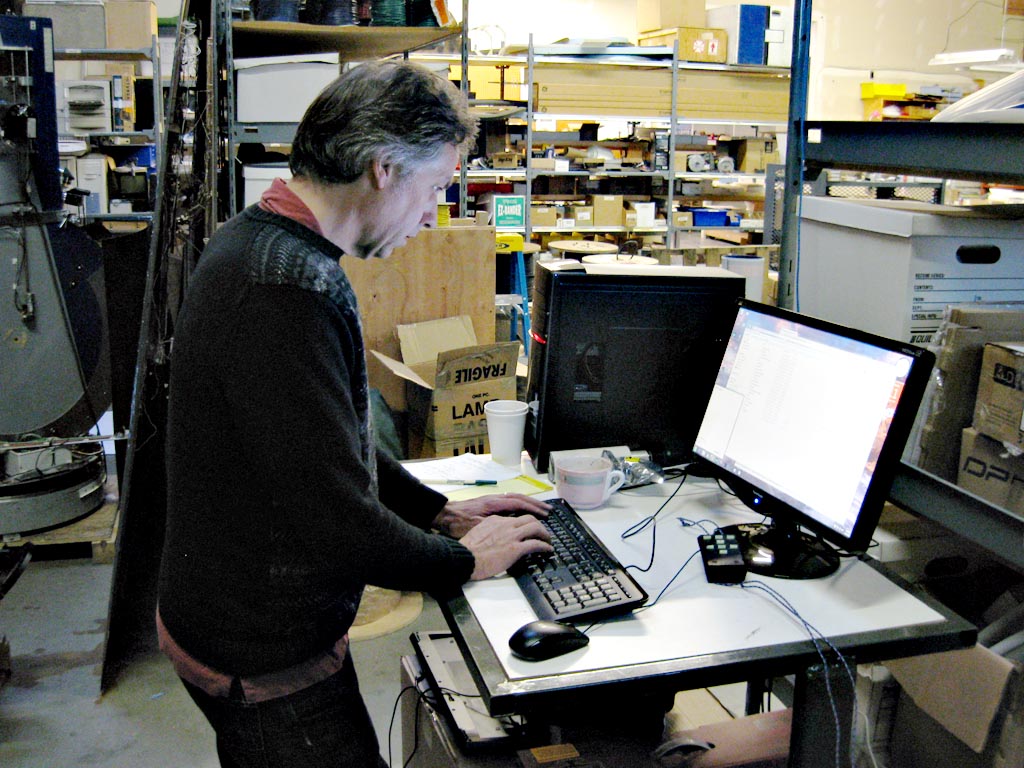
Once we had it set up, it was not necessary to go outside again. Here is Dan at the keyboard soon after we tracked a satellite. Aside from a few sanity checks, we ran the telescope (modeling the mount pointing, focusing, locating objects, and making images) entirely from the computer indoors.
Pointing and Focusing
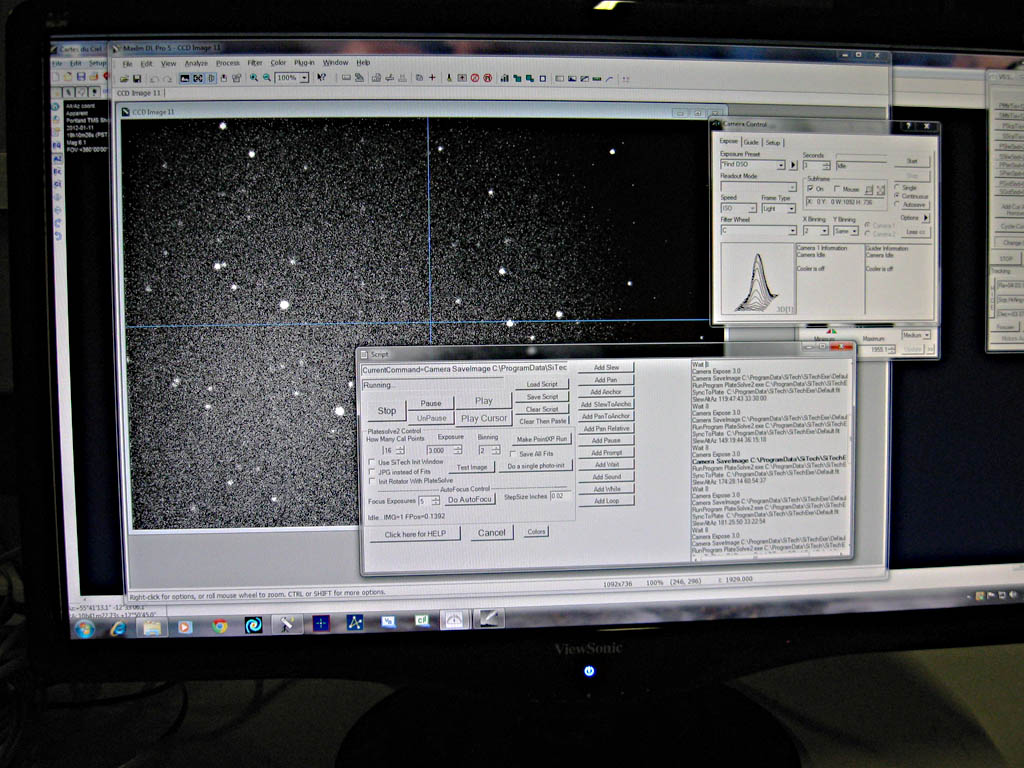
Here is SciTech script interface to PointXP for building pointing models and automatically finding best focus.
Satellite Tracking
![]()
This is a 60-second exposure centered on Atlas-Centaur Nrd=05816. The star trails show how smooth the tracking was.
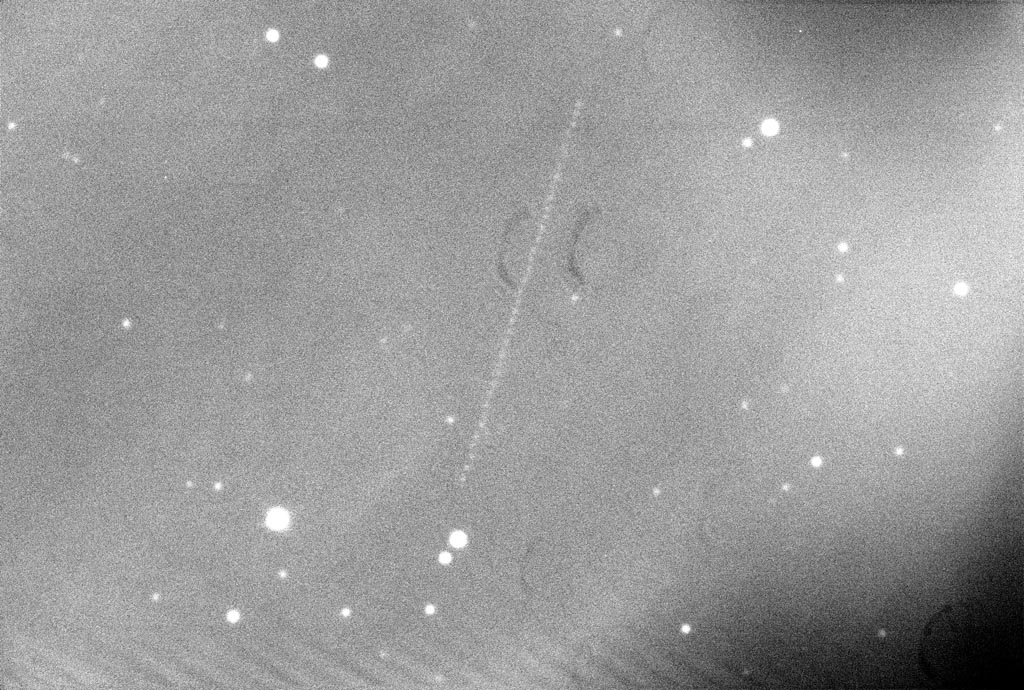
Here is a 60-second exposure of the satellite while the mount was tracking the stars. The tumbling satellite is a "blinker."
Next, we made a series of 60 exposures of 5 seconds each.
Dan made a video from these data: http://www.youtube.com/watch?v=D6Jo5vpwyAA&feature=youtu.be
The readout/save interval between frames was about 4 seconds.
Star Tracking
![]()
This may be the ugliest image of M33 ever made, but it is a 300-second unguided exposure. This picture demonstrates that the Cal Poly 18 performs as well as Dan (and many others) have hoped that it would. Treated a Gaussian profiles, measured star images have sigma = 3.8 pixels; FWHM = 9 pixels.
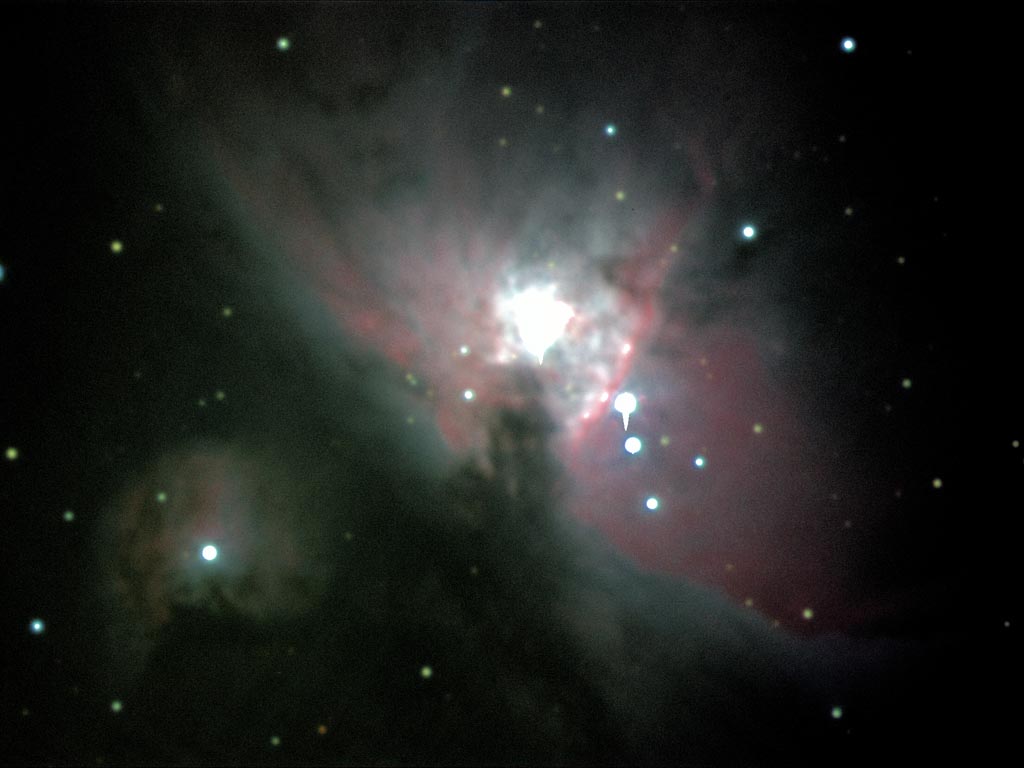
This is a our "pretty picture" for the night. It is an LRGB image R=10s, R=10s, G=25s, B=25s. Seeing was terrible. Blooming is present around the brighter stars; it was present for all exposures greater than 2 seconds.
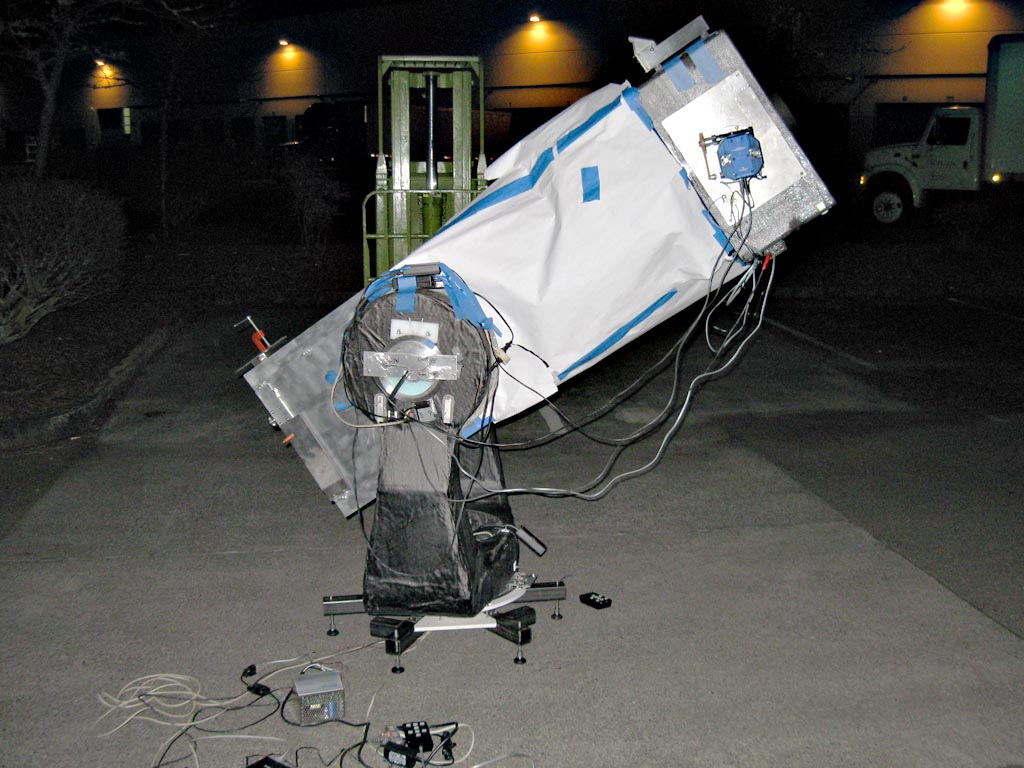
We do need to clean up the litter of power supplies, etc., eliminate dangling wires, install a better light shield, and generally tidy up all the messy experimental stuff so we can get into operational basis and begin "hardware debugging" and then efficient, effective data collection.
This is Cal Poly Bulletin 07
Main CalPoly Bulletin page or go back to Bulletin 06
Return to Richard Berry's Home Page